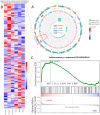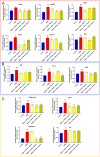The Peptide LLTRAGL Derived from Rapana venosa Exerts Protective Effect against Inflammatory Bowel Disease in Zebrafish Model by Regulating Multi-Pathways
- PMID: 38535441
- PMCID: PMC10972007
- DOI: 10.3390/md22030100
The Peptide LLTRAGL Derived from Rapana venosa Exerts Protective Effect against Inflammatory Bowel Disease in Zebrafish Model by Regulating Multi-Pathways
Abstract
Inflammatory bowel disease (IBD) is a chronic inflammatory bowel disease with unknown pathogenesis which has been gradually considered a public health challenge worldwide. Peptides derived from Rapana venosa have been shown to have an anti-inflammatory effect. In this study, peptide LLTRAGL derived from Rapana venosa was prepared by a solid phase synthesis technique. The protective effects of LLTRAGL were studied in a 2,4,6-trinitrobenzene sulfonic acid (TNBS)-induced zebrafish colitis model. The underlying mechanisms of LLTRAGL were predicted and validated by transcriptome, real-time quantitative PCR assays and molecular docking. The results showed that LLTRAGL reduced the number of macrophages migrating to the intestine, enhanced the frequency and rate of intestinal peristalsis and improved intestinal inflammatory damage. Furthermore, transcriptome analysis indicated the key pathways (NOD-like receptor signal pathway and necroptosis pathway) that link the underlying protective effects of LLTRAGL's molecular mechanisms. In addition, the related genes in these pathways exhibited different expressions after TNBS treatment. Finally, molecular docking techniques further verified the RNA-sequencing results. In summary, LLTRAGL exerted protective effects in the model of TNBS-induced colitis zebrafish. Our findings provide valuable information for the future application of LLTRAGL in IBD.
Keywords: 2,4,6 trinitrobenzene sulfonic acid; LLTRAGL; NOD-like receptor; Rapana venosa; inflammatory bowel disease; necroptosis; transcriptome analysis; zebrafish.
Conflict of interest statement
The authors declare no conflicts of interest.
Figures








Similar articles
-
Peptide GTSFTTTAER From Rapana venosa Alleviates TNBS-Induced Inflammatory Bowel Disease in a Zebrafish Model via Multi-Pathway Regulation.Food Sci Nutr. 2025 Jun 12;13(6):e70427. doi: 10.1002/fsn3.70427. eCollection 2025 Jun. Food Sci Nutr. 2025. PMID: 40521083 Free PMC article.
-
The alleviative effect of C-phycocyanin peptides against TNBS-induced inflammatory bowel disease in zebrafish via the MAPK/Nrf2 signaling pathways.Fish Shellfish Immunol. 2024 Feb;145:109351. doi: 10.1016/j.fsi.2023.109351. Epub 2024 Jan 1. Fish Shellfish Immunol. 2024. PMID: 38171429
-
Soluble Protein Hydrolysate Ameliorates Gastrointestinal Inflammation and Injury in 2,4,6-Trinitrobenzene Sulfonic Acid-Induced Colitis in Mice.Biomolecules. 2022 Sep 13;12(9):1287. doi: 10.3390/biom12091287. Biomolecules. 2022. PMID: 36139127 Free PMC article.
-
Preclinical Study in Vivo for New Pharmacological Approaches in Inflammatory Bowel Disease: A Systematic Review of Chronic Model of TNBS-Induced Colitis.J Clin Med. 2019 Oct 1;8(10):1574. doi: 10.3390/jcm8101574. J Clin Med. 2019. PMID: 31581545 Free PMC article. Review.
-
Modeling Inflammation in Zebrafish for the Development of Anti-inflammatory Drugs.Front Cell Dev Biol. 2021 Jan 15;8:620984. doi: 10.3389/fcell.2020.620984. eCollection 2020. Front Cell Dev Biol. 2021. PMID: 33520995 Free PMC article. Review.
Cited by
-
Structure and regulatory mechanisms of food-derived peptides in inflammatory bowel disease: A review.Food Sci Nutr. 2024 Jun 18;12(9):6055-6069. doi: 10.1002/fsn3.4228. eCollection 2024 Sep. Food Sci Nutr. 2024. PMID: 39554349 Free PMC article. Review.
-
Recent Advances of the Zebrafish Model in the Discovery of Marine Bioactive Molecules.Mar Drugs. 2024 Nov 30;22(12):540. doi: 10.3390/md22120540. Mar Drugs. 2024. PMID: 39728115 Free PMC article. Review.
-
Peptide GTSFTTTAER From Rapana venosa Alleviates TNBS-Induced Inflammatory Bowel Disease in a Zebrafish Model via Multi-Pathway Regulation.Food Sci Nutr. 2025 Jun 12;13(6):e70427. doi: 10.1002/fsn3.70427. eCollection 2025 Jun. Food Sci Nutr. 2025. PMID: 40521083 Free PMC article.
References
MeSH terms
Substances
Supplementary concepts
Grants and funding
LinkOut - more resources
Full Text Sources
Molecular Biology Databases

